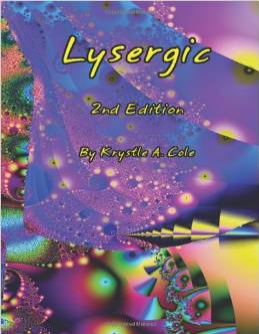Urban Shamans Amber Larson, Xochitl, Crystal Quintero, Dhr. Seven, CC Liu, Bela, Wisdom Quarterly; Hamilton Pharmacopeia (VICE/HBO, 2012); Krystle A. Cole (NeuroSoup)
 |
| "You should get out more," people may say. Maybe people should get in more, like Alice. |
TOPEKA, Kansas - Former goth stripper, author of Lysergic, and producer of numerous YouTube videos Krsytle A. Cole talks about her time spent living in an "Underground Acid Palace," a subterranean missile silo converted into a luxurious LSD-manufacturing facility.
She take Hamilton and VICE's cameras on a tour into the rabbit hole. We're not in Kansas any... well, apparently, we still are. And this time it's underground just like Alice in Wyrd (another word for Wonderland).
Krystle Cole spent three years of her life running from the DEA, being held partially against her will and used as a guinea pig for strange new psychedelic chemicals.
Eventually her friends-turned-captors were arrested, whereas Krystle herself barely escaped incarceration.
She now makes her living as a writer, sharing her experiences in books and on the Web in her firsthand and Erowid.org-style accounts of experimenting with entheogens and other forbidden substances on NeuroSoup.
She take Hamilton and VICE's cameras on a tour into the rabbit hole. We're not in Kansas any... well, apparently, we still are. And this time it's underground just like Alice in Wyrd (another word for Wonderland).
Krystle Cole spent three years of her life running from the DEA, being held partially against her will and used as a guinea pig for strange new psychedelic chemicals.
 |
| Lysergic, 2nd ed. (goodreads.com) |
She now makes her living as a writer, sharing her experiences in books and on the Web in her firsthand and Erowid.org-style accounts of experimenting with entheogens and other forbidden substances on NeuroSoup.
 |
| I wonder, I wonder, I wonder what's down in there! (Alice at the gate of the Rabbit Hole) |
 We can't help but observe how much she looks like someone we knew, both in terms of her features and her mannerisms, who eventually became an expert Buddhist meditator and stream enterer. Of course, people do not believe anyone get enlightened nowadays. They do. How do we know? we'll be asked. That was courtesy of a strange set of circumstances too hard for others to believe. We believe it. We were there. We saw and understood.
We can't help but observe how much she looks like someone we knew, both in terms of her features and her mannerisms, who eventually became an expert Buddhist meditator and stream enterer. Of course, people do not believe anyone get enlightened nowadays. They do. How do we know? we'll be asked. That was courtesy of a strange set of circumstances too hard for others to believe. We believe it. We were there. We saw and understood.DRUG DISCUSSION
Wisdom Quarterly (URBAN SHAMANISM)
 |
| The lights, the lights, painting with light (DigitalTurkey-Graph/flickr.com) |
.
 |
| The devas still descend from space. |
(Gnosis) "DMT: The Spirit Molecule," which explores human consciousness, weaves an account of Dr. Rick Strassman's groundbreaking DMT research through a multifaceted approach to this intriguing entheogen/hallucinogen found in the body, brain, and hundreds of plants.
And this DMT is not out there. It's in here, in the center of our brains, behind the third eye, where the pineal gland is enclosed in gray matter with active rods and cones and its own inner-retina.
There are many ways to awaken it. "Drugs" are the worst way. People are not ready to see it. Amber, does Buddhism have anything good to say about drugs? I think we all agree with Dr. Gabor Mate that the problem of "drug use and abuse" is that almost no one in the U.S. who sets out to get high is actually trying to get high. They're just trying to get wasted.
There are many ways to awaken it. "Drugs" are the worst way. People are not ready to see it. Amber, does Buddhism have anything good to say about drugs? I think we all agree with Dr. Gabor Mate that the problem of "drug use and abuse" is that almost no one in the U.S. who sets out to get high is actually trying to get high. They're just trying to get wasted.
 |
| Befriending Faeries |
They are trying to obtund (dull) rather than enhance consciousness, trying to get blotto, blitzed, full of toxins or intoxicated. Right, Seven? That's right! We use the same word to mean exact opposite things -- doped up or wasted versus opened up and trying to see things as they really are.
Whatever there is of substances to get "high" on, that exists within for us to access. Crystal? There are Tibetan lamas who do dream yoga. But look at the yogis of olde, not the ganja-obtunded waste-cases sitting around growing great dreadlocks and clutching hash pipes. Maybe they would have taken or produce Soma and Amrita, the "nectar of the devas."
 |
| Yogis sometimes veer off the path (D. Earlotti) |
 |
| The subtle little fairies/devis in art (1909) |
 |
| Devas watch as liberator is born. |
But if one pursues awakening the pineal gland, the third eye, the seat of consciousness, the "mind door" around the heart may get something else, awakening and liberation. But real liberation is not transient. It does not fall away. Drug experiences, absorptions (jhanas), hallucinations, and delusions do. The Five Precepts warn us away from intoxicants. This is very wise. Mere "knowledge" (ñāna), study (suta), and experience cannot substitute for actual wisdom (Sanskrit prajñā, Pali paññā).
Embodying DMT as "Soma"?
Stephen T. Naylor, Encyclopedia Mythica (pantheon.org)
_Flaxman_Ilias_1793,_gestochen_1795,_186_x_358_mm.jpg) |
| The devas depicted in Western/Greco-Roman forms (Ilias Flaxman, Gestochen/Wiki) |
.
 |
| Where earthbound devas dwell, Plitvice |
He is also an intoxicating drink which was brewed from that plant [which plant or mushroom, root or vine is disputed]....Though he is never depicted in human form, Soma obviously did not want for lovers [i.e., people who loved it]; poets rarely do.
In one episode, his desires caused a war. He had grown arrogant due to the glory that was offered him. Because of this, he let his lust overcome him; he kidnapped and carried off Tara, the wife of the [deva] Brihaspati. After refusing to give her up, the devas made war on him to force her release, and Soma called on the [titans] asuras to aid him.
Finally, Brahma interceded and compelled Soma to let Tara go. But she was with child, and it ended up that this child was Soma's. The child was born and named Budha (not to be confused with the Buddha). More
 |
| There is a "road" (path) to a weird "land" (place) somewhere outside of this illusion. |
.
Is it Amrita, the endogenous nectar of our divine nature?
Wisdom Quarterly edit of Wikipedia entry
 |
| Mohini, female-Vishnu with Amrita pot (W) |
Amrita is repeatedly referred to as "the drink of the devas, the "gods," which grants them "immortality."
- Immortality? Perhaps that timeless vision or realization of who we really are, which does not end at death; our personality ends, and self falls away, but something, some whole, some connection to everything else, remains or is reborn, taking and clinging to a new form it immediately mistakes for "self" again. We are not so limited as any expression or manifestation would suggest.
Amrita features in the "ocean-churning" Samudra manthan legend, which describes how the devas, because of a curse from the sage Durvasa, begin to lose their immortality (divine vision of themselves?
Assisted by their mortal enemies, the asuras (Buddhist "titans"), they churn the ocean (cosmos, world-system, Milky Way, samsara) and create -- among other wonderful (Wyrd) things -- Amrita, the nectar of immortality.
In yogic philosophy (as it found its way from Hindu philosophy into its cognate Mahayana-Buddhism), Amrita is a fluid that can flow from the pituitary gland down the throat in deep states of meditation. It is considered quite a boon: Some yogic texts say that one drop is enough to conquer death and achieve immortality. More


















































































































































































































































No comments:
Post a Comment